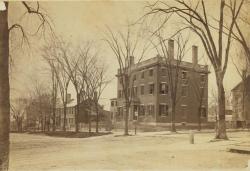
Auburn City Farm, 1930
Androscoggin Historical Society
Homes for the Indigent
Taking care of those in need represents an abiding trust of human society. Native traditions of caring for the indigent mirrored common European practices: the poor, aged, and ill were taken care of by their clans or families within their own communities.
When those options were not available, towns took care of the indigent or ill on town farms or in almshouses. When Maine settlements expanded, and native groups diminished in size late in the 18th century, both sought alternatives to those earlier practices.
The 19th century in particular saw the emergence of increasing numbers of charitable refuges and asylums across the country. While Maine built its share of such institutions, most were located in urban areas. Many communities – large and small – had town farms that served as homes for the indigent. Bangor built its Children's Home in 1835 while a Home for Aged Men opened in Portland in 1881 followed by the Temporary Home for Women and Children in 1882.
The latter was championed by the inestimably civic-minded, Fannie Clifford Brown, whom a contemporary described as its "steadfast friend." Apparently Mrs. Brown remained the Home's "ardent champion" despite the assertion that "it was frowned upon by the community as an ill-advised institution."

Alms House agreement, Houlton, 1867
Cary Library
Portland was especially blessed with an abundance of benevolent societies including the Ladies' Relief Society (established in 1846 "for the relief of shipwrecked and destitute mariners"), the Portland Benevolent Society (organized in 1803 "to relieve and assist those who might require relief in a manner different from that which is by law provided"), and the Female Charitable Society (from 1812, "conducted wholly by ladies" and considered "a very efficient agent in relieving the poor of the city").
Private charities like the Portland Widows' Wood Society, established in 1830 to distribute fuel to needy widows, supplemented other community institutions like orphanages and various "homes" for the aged and destitute. The Wood Society was part of a larger and well-established charitable response to fuel shortages in the nation's urban areas that dated back to the early republic.
Benevolence sometimes acquired a patriotic gloss as caring for the nation's veterans became especially critical following the Civil War. Authorized by the U.S. Congress, the National Home for Disabled Volunteer Soldiers opened as a residential facility in Togus in 1867, the first of 10 that housed growing numbers of Union veterans from Maine to California.
The Home was essentially a self-sustaining planned community of barracks, shops, farmlands, and educational and entertainment facilities built on the site of a former resort. Its mission changed over the years as new wars were fought and the Veterans Administration charge developed accordingly. Unlike other indigents, honorably discharged veterans were not considered paupers, and retained their citizenship rights.
The Bath Military and Naval Orphan Asylum combined the sensibilities of caring for selected orphans with respect for the sacrifice of military veterans. It opened in 1866 to house children orphaned by the Civil War, making Maine one of only seven states of the former Union to do so.

Home for Aged Women, Portland, ca. 1900
Maine Historical Society
Such homes were intended in part "to obviate the necessity of sending the orphans of soldiers to orphan asylums or poor houses." Their charter was later amended to include grandchildren of Civil War veterans and orphans of soldiers and sailors killed in the Spanish-American War.
Most towns had no problem justifying institutions for veterans and orphans; the local poor presented more of a moral dilemma. Concerned citizens sought to differentiate between the deserving, virtuous poor --– those impoverished through a combination of circumstances and ill fortune, but who still retained their essential goodness—and the undeserving and vicious poor, impoverished through their own reckless behavior, consumption of alcohol, or general fecklessness.
Help for the deserving poor was always easier to rationalize and administer than assistance for the unworthy and unrepentant. As a result, a variety of civic organizations and charitable institutions like Ladies Aid Societies insisted on verifying the worthiness of their objects of charity before providing services.
In addition to its private charitable associations, any town could open a workhouse for its able-bodied poor, which many saw as preferable to almshouses. Public houses of refuge for the poor could thereby subsidize expenses by putting their charges to work. Contracted out by the day, or even the year, workhouse inhabitants thus could learn a trade as they helped pay for their support.

Dunlap house, Portland, ca. 1880
Maine Historical Society
Towns assessed taxes for the support of the indigent in almshouses or workhouses, but pauper auctions were another alternative. Pauper auctions allowed towns to pay someone else – the lowest bidder, who then benefited from the labor of those auctioned into his care – to feed and house the poor when they lacked facilities to care for them themselves.
While this was not the most common form of dealing with the state's impoverished residents, these auctions offered a local solution to the chronic problem of pauperism and persisted well into the 19th century. As with many such practices and institutions, however, the state eventually took over, or at least subsidized the care for impoverished Mainers. Government expenditures in 1885, for example, included $8,000 for the support of paupers in the unorganized territories.
Given the conditions of the times and the vicissitudes of personal circumstances, it is not surprising that the public charitable system, and the poor it sought to manage, was abused. Exploitation of these practices was a way for some to maximize a marginal existence akin to stealing fruit, hunting out of season, or otherwise seizing opportunity.










